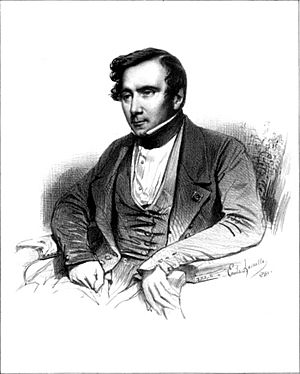Augustin Thierry facts for kids
Quick facts for kids
Augustin Thierry
|
|
|---|---|
 |
|
| Born |
Jacques Nicolas Augustin Thierry
10 May 1795 |
| Died | 22 May 1856 (aged 61) Paris, France
|
| Era | Modern philosophy
|
| Region | Western philosophy
|
|
Influences
|
|
Augustin Thierry (born Jacques Nicolas Augustin Thierry; 10 May 1795 – 22 May 1856) was a famous French historian. He started as a follower of Henri de Saint-Simon, a thinker who believed in a better future society. Later, Thierry created his own way of studying history. He was a strong supporter of freedom and often wrote history in a dramatic, exciting way. He also made sure to use original documents and records in his research. People saw him as an important historian, especially for his work on how local governments (called communes) developed.
Contents
Early Life and Education
Augustin Thierry was born in Blois, France. He was the older brother of Amédée Thierry, who also became a historian. Augustin didn't come from a rich or powerful family. However, he was a very bright student at the Blois Grammar School. In 1811, he joined a special school called the École Normale Supérieure. He briefly worked as a professor in Compiègne in 1813.
Career as a Historian
Working with Saint-Simon
Thierry was very excited by the ideas of the French Revolution. He also liked Saint-Simon's ideas for a perfect future society. For a short time, Thierry worked as Saint-Simon's secretary. He even helped Saint-Simon write a paper called De la réorganisation de la société européenne. This paper suggested that Europe should unite under one constitution. By 1817, Thierry decided to focus on history instead of politics.
Inspired by Romanticism
Thierry was also inspired by Romantic literature. This included books by authors like François-René de Chateaubriand and Walter Scott. These books often told exciting stories with a lot of emotion. Thierry didn't write romance novels himself. But he believed that history should also show the dramatic parts of past events. For example, he saw the clash between the Roman Empire and Early Christianity as a dramatic story.
Studying History and Primary Sources
Thierry's main ideas were about the Germanic invasions and the Norman Conquest of England. He also studied how local governments (Communes) were formed. He wrote about how nations slowly moved towards free governments and parliamentary systems. He shared these ideas in articles he wrote for newspapers like Le Censeur européen (1817–20). Later, he put them into his book Lettres sur l'histoire de France (1820).
He learned from another historian, Claude Charles Fauriel, how to use primary sources. These are original documents from the time period being studied. Using old Latin records and Anglo-Saxon laws, Thierry wrote his famous book, Histoire de la Conquête de l'Angleterre par les Normands (History of the Conquest of England by the Normans) in 1825. This book was very popular. He wrote it in a clear and vivid style. It focused on the idea that Anglo-Saxon freedom fought against the Norman invaders. It also showed how this freedom later led to a parliamentary monarchy. In this book, Thierry even suggested that Robin Hood was a leader of the Anglo-Saxon resistance.
This hard work on the book sadly caused Thierry to lose his eyesight. By 1826, he needed secretaries to help him, and he eventually became completely blind. But he kept writing!
Later Historical Works
In 1827, he re-released his Lettres sur l'histoire de France. He added new sections that described exciting moments in the history of medieval communes. He used records from the 11th and 12th centuries and old town charters for his research.
Thierry strongly supported the July Revolution in 1830. This revolution brought more liberal ideas to France. His brother Amédée was given an important government job, and Augustin lived with him for four years. During this time, he re-edited his early writings. He also wrote Récits des temps mérovingiens. In this book, he told vivid stories from the history of the Merovingian kings, based on the writings of Gregory of Tours.
Recognition and Awards
Augustin Thierry became a member of the Académie des Inscriptions et Belles Lettres in 1830. In 1841, the Académie française gave him the first Prix Gobert. This was a very important award, and he continued to receive it for the next fifteen years. He was also asked to help edit a large collection of documents about the history of the Third Estate. With the help of others, he put together four volumes called Recueil des monuments inédits de l'histoire du Tiers Etat (1850–70). This collection focused on northern France. The introduction to this work was later published as a separate book, Histoire du Tiers Etat.
Later Years and Legacy
Augustin Thierry is remembered for starting the serious study of local government institutions in France. The last years of his life were difficult. In 1844, he lost his wife, Julie de Querengal, who had helped him a lot with his studies. The Revolution of 1848 was another sad event for him. This revolution changed the government that he had supported for so long.
Thierry passed away in Paris in 1856.
Works
- 1814 De la réorganisation de la société européenne (written with Saint-Simon)
See Also
 In Spanish: Augustin Thierry para niños
In Spanish: Augustin Thierry para niños
- Jules Michelet
- Henri Martin (historian)

